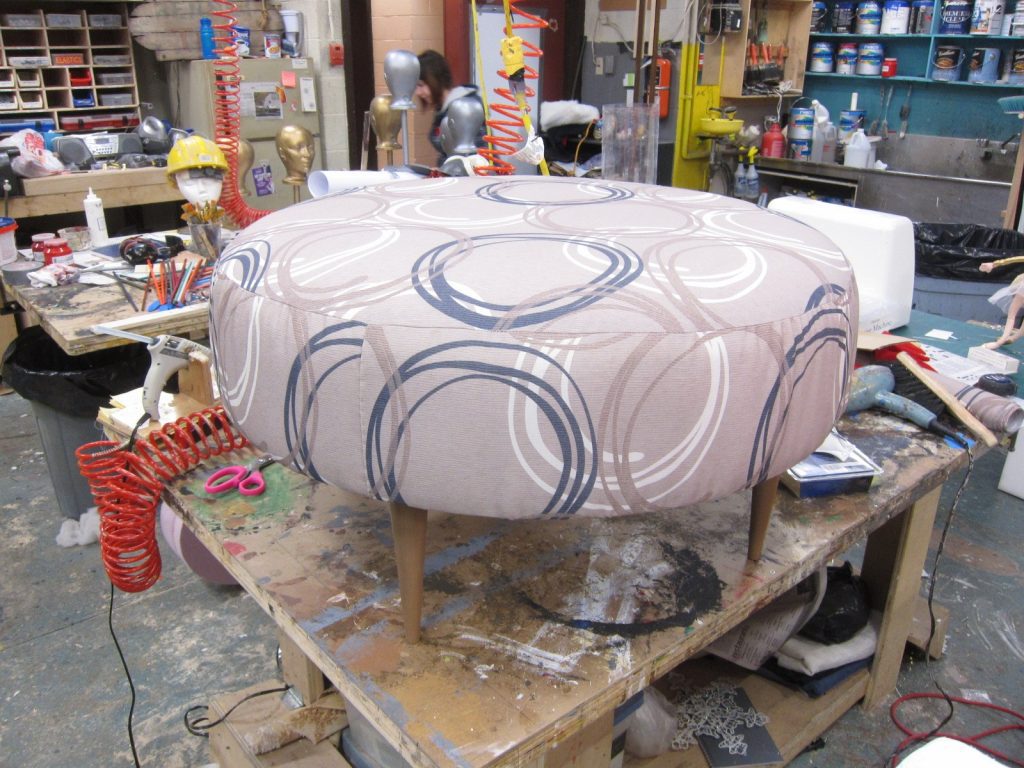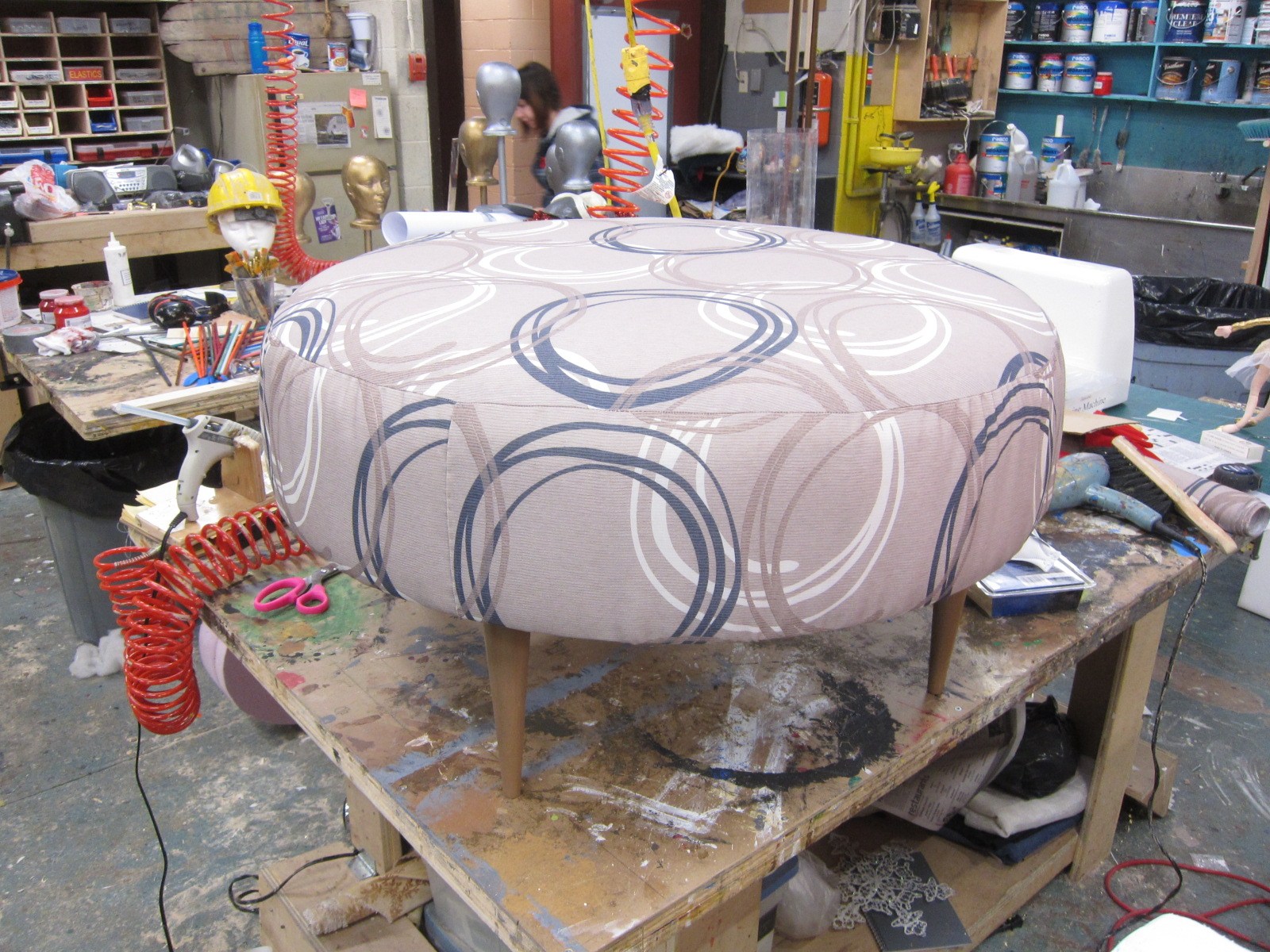An experienced woodworker may know everything there is to know about the types of wood they work with, while still being totally ignorant about other materials that might be used in conjunction with them. One category of materials that most woodworkers know little about is upholstery materials. Yet one doesn’t have to build too many pieces of furniture, before being confronted by upholstery, whether the woodworker attempts to do the upholstery work themselves or farms it out to an upholstery shop.
Even if the work is to be farmed out, it’s important to have at least a basic understanding of what to ask for. Knowing the materials used and the specifications for that material will help ensure that the work that is provided matches what’s desired. Without that basic knowledge, it’s unlikely that what is done will match what is wanted.
Generally speaking, quality upholstery work involves a number of different materials, arranged in a way to provide the maximum comfort. Chief amongst these materials is the foam that becomes the main filling for any cushions. While many people may think a particular foam or a particular thickness of foam is ideal, a lot depends on the actual use of the piece of furniture and how long it is intended to last.
Upholstery foam comes in thicknesses of 3/8” to 30”, although thicknesses under 8” are more common. Even a cushion that is 8” thick is likely to be made of more than one type of foam, with a firmer foam on the bottom for support and a softer or “plusher” one on top for comfort. A thin layer of polyester fiberfill may be layered on top of that, to help provide a means for the upholstery fabric and foam to move against each other, rather than sticking. Mattresses, perhaps the most complex use of upholstery foam there is, are generally a sandwich of several different types of upholstery foam and other materials.
Important Foam Terms
As with any other field of human endeavor, upholstery has its own language. These terms tell us key things about the various materials used in upholstery work, such as the foam that is used.
Density
Foam density is a measure of how much air there is in a piece of foam, compared to how much of the material the foam is made of. Typically, this is expressed as a number, ranging from 1 to 3. Foam above 1.8 density is considered to be a “high density foam.” Better grades of foam will have a higher number. This does not indicate how firm the foam is, as it is possible to have a high-density foam that is still soft or a low-density foam that is firm, depending on the material that the foam is made of. Instead, this is the biggest indicator of how long the foam will last with repeated use.
By and large, furniture that receives constant use, like a living room sofa, needs to have high density foam in it. Furniture like that, which receives daily use, but is made of low-density foam will not last, wearing out in as little as a year. On the other side of that coin, spending extra money for high-density foam on upholstery work that is seldom used, like boat cushions, is merely a waste of money.
Firmness
Firmness refers to the support that the foam provides. Just like a mattress can be soft or firm, a seat cushion can be too. If that seat cushion is on more formal furniture or furniture with only a couple of inches of padding, it’s important that the foam be firm. On the other hand, if the cushion is on a sofa in the family room, where people lounge on the sofa, rather than sitting on it, it makes more sense to use a softer foam.
Foam firmness is measured by the foam’s Indentation Force Deflection (IFD). This is measured by pressing a 50 square inch circular plate down into the foam, 25% of its thickness. So for a 4” thick piece of foam, the testing would compress it down to 3” of thickness. The amount of weight it takes to compress the foam by that amount is its IFD rating. The following chart breaks down foam firmness, based upon the IDF test results:
| Amount of Weight | Firmness |
| Less than 30 lbs. | Soft |
| 30 – 45 lbs. | Medium |
| 45 – 75 lbs. | Firm |
| Over 75 lbs. | Extra Firm |
Foam Usage
The foam usage ties in directly to the foam’s density and refers to how frequently the foam is being used. The more a piece of furniture is used, or the higher the frequency, the more necessity there is to have a higher density foam. But it’s not like there are only two types of foam: low-density and high-density; rather, there are graduations of density from one end of the scale to the other.
Within a home, we may find a considerable range of usage, from the family room sofa that is used several hours per day to the living room furniture or the formal dining room, which is only used for special occasions and when guests come to call.
Antimicrobial Foam
Some types of foam are rated as antimicrobial. This means that the foam has an additive in it, which was mixed in with the foam when it was molded. The purpose of this additive is to deter the growth of fungus in the cushion. Antimicrobial foams are especially important for out furniture or for cushions on boats, as those tend to get wet often. Spending the extra money for antimicrobial foam is unnecessary for the living room sofa. These foams are usually only medium and high-density foams that do not drain water well, like polyurethane foams.
Reticulated
Reticulated foams are designed to dry quickly, when they get wet. The term “reticulated” refers to the cell walls of the foam being blown out, creating easy paths for air and water to travel though. This helps water to drain out of the foam more quickly.

Types of Foam
A quick look at any upholstery house or even the specifications of mattresses will quickly reveal that there are a wide variety of foam materials used in upholstery work. It might be easy to conclude that this is mere competition, if one were to glance quickly, without looking at the actual differences between the various types of foam. But in fact, these different types exist, because of their different characteristics.
Polyester Fiberfill
While this is not a true foam, it is a very common upholstery material, usually used as a top layer, over other foam products. Made of blown polyester fibers, it is commonly used as a stuffing for pillows. It can also be used for deep seat back cushions that the person is expected to sink into. For such pillows, the polyester fiberfill is usually inserted into a sewn cover, which is then inserted into the upholstery fabric.
Medium Density Polyurethane Antimicrobial Foam
This is a very common material for seat bottoms and mattresses. Polyurethane tends to soak up water, hence the need for it to be antimicrobial. It is best used in cases where the upholstery is not likely to get wet. As a medium-density foam, this is best for occasional use, rather than daily use.
High Density Polyurethane Foam
This is a similar product to the medium-density foam above; however, being of a higher density, it is a longer-lasting product. Furniture cushions made with high-density polyurethane foam can be expected to last 10 to 12 years of daily use, even the hard daily use of children playing on it. The foam is also available in an antimicrobial version and comes in medium, firm or extra-firm firmness levels to meet everyone’s preferences.
Dry-fast Open Cell Foam
This is a foam specifically developed for use in outdoor furniture or for marine use, where cushions are expected to become wet. Being of open cell design, water drains quickly, allowing the foam to naturally resist mold and fungus. This is a name-brand foam, with a considerable number of knockoffs on the market. To test whether the foam is truly an open cell foam, pour water on it and look to see if the water immediately drains out the bottom.
Closed Cell Foam
Closed cell foam is a more expensive option than high density foam. It is unique in that it strongly resists moist absorption. This makes it buoyant, without the risk of becoming waterlogged. That makes it ideal for marine applications, including life-vests. At the same time, this foam is high density and firm, making it a good foundation for use in applications where it will be covered with another layer of foam.
Fabric-backed Sew Foam
This is a thin, specialty product used in cases where it might be necessary to sew the foam to the upholstery fabric, such as in the case of making pleats in upholstery work. The fabric backing also works well for gluing the foam to other materials, such as putting a padded layer on wood structure, like the fronts of arms of sofas, where people will not be sitting on the foam, but a soft look is desired. When glued to that wood structure and covered with the same upholstery fabric used on the rest of the sofa, it appears as if the front of the sofa’s arm is upholstered as well.
Memory Foam
Memory foam is a newer addition to the market. Designed to be a foam that has good shape retention, memory foam doesn’t spring back instantly when weight is removed from it. This also means that it pushes back less on someone’s body, when they are sitting or lying on it, reducing pressure points. At the same time, it provides less support than other types of foam. Memory foam is almost always used in conjunction with other types of foam, usually forming the top layer.
Common Foam Usage
As is clear from the information we’ve already discussed, selecting the right foam for a piece of furniture can be a complex operation. More than anything, personal preference comes into play, as each of us have our own idea of what’s most comfortable. Making the right chose requires knowing the desires and expectations of the end user. Nevertheless, here are a few basic guidelines:
| Usage | Recommended Foam Type | Recommended Foam Thickness |
| Dining room chairs | Medium density 2.2#, IFD 45 | 1-2” |
| Sofa and chair seat bottoms | High-density 3.1#, IFD 33 | 4-6” |
| Loose back cushions | Low-density 1.3#, IFD 9 | To match seat bottom |
| Attached back cushion | Medium-density 1.8#, IFD 18 | To match seat bottom |
| Headboards | Low-density 1.3#, IFD 12 | 1-2” |
| Window seats | High-density 3.1#, IFD 45 | 2-4” |


